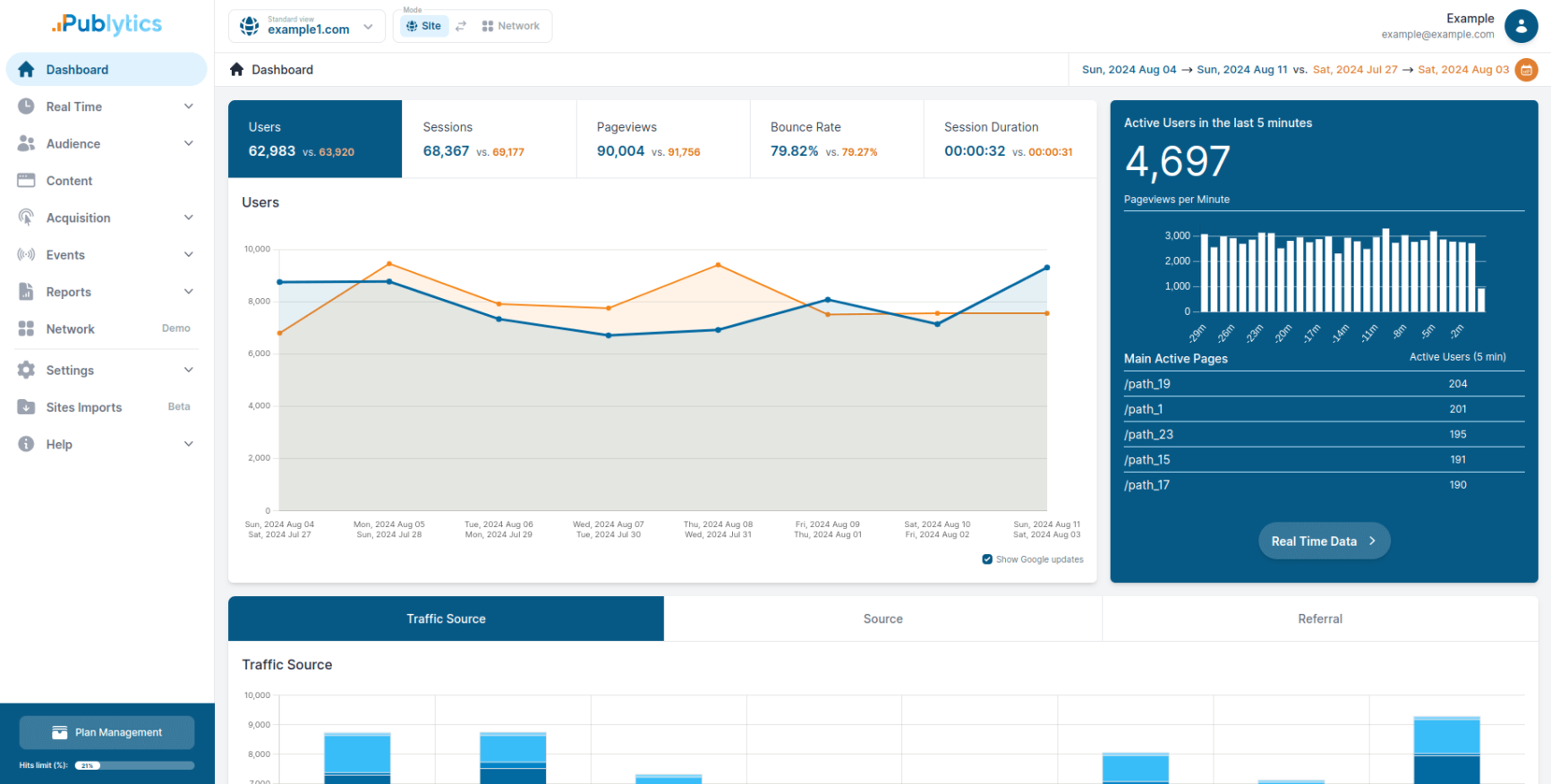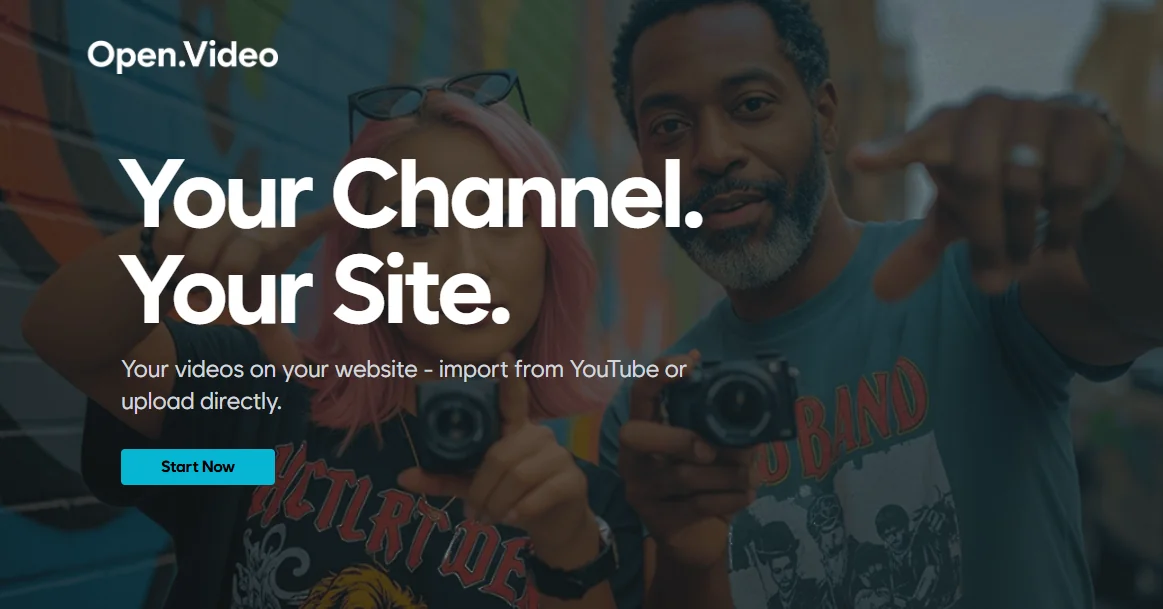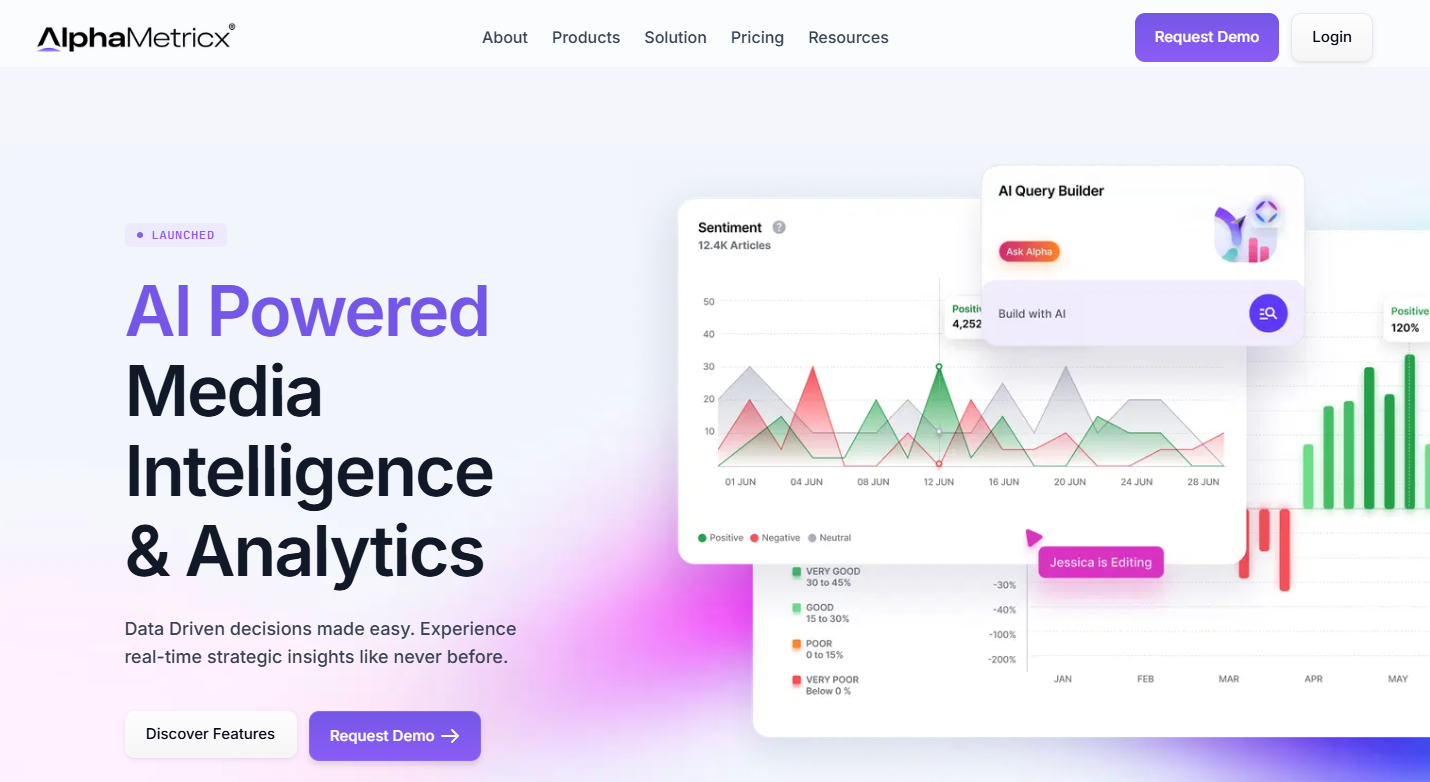Social media distribution has a big role in developing audience interaction and engagement for publishers. According to 2018 research from the Pew Center, 47% of the US population get their news on social media at least sometimes, up from 44% in 2016.
And for most people, social platforms are becoming the internet. According to a survey from GlobalWebIndex, 86% of internet users aged 18-64 use at least one of the Facebook-owned platforms (Facebook, Instagram, Messenger, and WhatsApp). This means that a social media strategy is increasingly becoming a digital strategy. Facebook accounts for 30% of referral traffic for digital publishers, according to a WAN-IFRA report, at the same time that it competes with them for digital advertising money: Facebook owns 22% of the digital advertising market in the US.
Publishers can have three main objectives when distributing and publishing content in social media platforms, as identified by Harvard Business School researcher Grzegorz Piechota and researchers at the Reuters Institute:
-
- Increase aggressively the consumption of their content by publishing beyond their owned properties. This strategy prioritizes the circulation of their content and the visibility of their brands among social media users over traffic share from social platforms. As driving traffic to their sites is not a priority, this approach is hard to monetize and can be undertaken only if the main source of revenue is different from advertising, as is the case of state-owned companies or brands, or if they want to prioritize increasing their reach over monetization.
- Prioritize control over the growth of their audience base. Some publishers prefer to have a direct relationship with their users, so they treat social media platforms as content marketing channels. The focus of these publishers is to drive traffic to their sites and monetize them through advertising and subscriptions.
- Learn through experimentation. Some publishers launch new brands as experiments to learn about new opportunities in expanding their reach or discover a social platform’s capabilities. This allows publishers to learn in a fail-safe environment that doesn’t impact their main brands. But any new knowledge they get can be repurposed to strengthen the approach of the main brand. As social platforms are constantly evolving, and adding new capabilities and features aimed at publishers, like Facebook Instant Articles or Facebook Audience Network, having a playground to try and experiment with new features without impacting the main business model is becoming more necessary to publishers.
Key social media distribution strategies
The most basic approach is just to use social media as a channel for content distribution and a source of traffic. But there is a segment of publishers that are taking their approach to social media to a new level by developing storytelling and adopting native formats in social media platforms.
Adapt your content to the social platform native formats
Each social media platform has its own formats and language, and users in each platform tend to favor certain types of content over others.
For example, Instagram is a visually-rich social media platform, in which stories, a format where you can play a short video or a static image for a few seconds, was on track to surpass the feed as the main sharing channel back in 2018. The Story is a format originally developed by Snapchat, but it has become an industry-standard now adopted by Instagram, Facebook and WhatsApp (all owned by Facebook) among others. Even Google is adopting the story format to show them in search results pages.
Publishers like The Economist or Vogue have been successfully using this format in Snapchat and Instagram, respectively. For The Economist, their presence in Snapchat serves as a content discovery tool that brings the brand to a new, younger audience. They even have a dedicated Snapchat editor to create and adapt content to this platform. Vogue has been hugely successful in their experiments with their story format. As an example, their campaign around the launch of the September 2018 issue managed to help sell out that edition of the magazine. 20% of their new subscriptions in that period were directly attributed to their usage of Instagram stories.
In contrast, Twitter, while having the option to share visual content like videos and images, is more focused on text. Twitter threads, in which a story is told via chain-linked short messages (often sprinkled with images or gifs), are wildly popular.
This means that the same piece of content, when being distributed on social media sites, must be adapted to the different native formats for each platform to be successful. For example, adapting long-form investigative pieces into shorter pieces or videos for Facebook with an angle chosen to attract a social audience. The shorter piece would then link to the main article on the website. Another example could be creating stories crafted specifically for social media, using polls, live coverage, or the story format. Some of these social media pieces could make their way later into the website.
Of course, not even the big names like the New York Times have the resources to do this for every piece of content, nor should they. Content distribution has to take a strategic approach to determine what content is appropriate for each social platform, and which content might benefit from a bigger impact by using specialized native formats. Not all content needs to be shared on social media, and not all content is appropriate for every social media network.
Know your social media audience profile and preferences
There’s also the consideration that the audience in different platforms may want different kinds of content. According to research from the Pew Center, Twitter, Reddit and Facebook users are much more likely to get their news through that social media platform than users from Snapchat, Instagram or LinkedIn. But when looking at the audience profile of users who get their news from Snapchat, they are for the most part young and female, so if that’s your target audience, you’d need to have a presence in Snapchat, but not necessarily on Reddit, where news-focused users are mostly young but male.
Ultimately, publishers need to know their audience, understand their preferences and motivations so that they can serve them better by providing the content they want, where they want it.
This knowledge will also be useful to publishers to understand in which social media networks they need to invest their resources. Focusing on one or two social media platforms is not a healthy strategy. What if the platform goes into decline? Myspace used to be the biggest social media network until it was surpassed by Facebook in 2008. Other big names in social media could follow the same fate in the future.
Other points to evaluate are algorithmic changes and updates that impact the way brands and publishers reach their audiences. They are essentially using someone else’s platform to reach their audience. If the rules change as with Facebook algorithm update in 2018, which prioritized posts from friends and family over brands and pages, there is nothing they can do.
Increase your reach through paid campaigns
One of the consequences of playing by someone else’s rules is that organic reach for brands and publishers will only take you so far. The social media platforms are designed so that, at some point, publishers will need to spend money to increase their reach and keep building their audience.
The upside is that social media platforms offer plenty of sophisticated advertising features that allow brands and publishers to reach the users they want with the content they need. Facebook, for example, allows brands to reach people by demographic data, location, and interests. You can also build lookalike audiences, in which you can use a seed audience, for example, the visitors to your Facebook page, and the social platform will present you with a new set of users you can target which match the characteristics of the seed audience. LinkedIn also offers this advertising option.
The level of personalization that social media platforms allow means that brands and publishers can effectively target their promoted content to the people who will be more interested in it.
Text messaging apps are the new social media frontier
When talking about social media platforms, people instantly think of Facebook, Instagram, Twitter and the like. But messaging apps like WhatsApp and Telegram have evolved and have included some features, like the Story format, from social media. They could also be considered social networks on their own, and not just messaging apps.
Publishers and news media are already using these apps for delivering news and engaging with their audience. For example, in Ukraine, the Ukrains’ka Pravda newspaper has several Telegram groups which they use to disseminate stories. Their main group has more than 18.000 subscribers. The Newsroom is a news product developed directly in Telegram, which has more than 6.000 subscribers.
News media experiments with WhatsApp have been even more successful. The german media publisher Axel Springer experimented with a WhatsApp group about political news for young people between 18-24 years old. They used the native formats of the social app, like Status, (WhatsApp version of the story format), audio and text messages. In India, the Quint developed several WhatsApp groups focused on business news, fitness, and general news. Their business news venture was the most successful, with almost 270.000 subscribers.
The Telegraph, in the UK, is another news media company that has launched several WhatsApp groups. One of them distributes a two-minute bulletin called The Briefing. But they have also other WhatsApp groups for people interested in Brexit, cricket, and royal fashion.
Unfortunately, these WhatsApp experiments won’t continue in the future. WhatsApp has stated that sending bulk messages is against their terms of service. Since December of 2019, publishers can no longer send newsletters using WhatsApp or WhatsApp Business. This is another reminder that social platforms can change the rules at any moment and impact publishers unexpectedly,
How algorithms shape what content we see in social media
As social platforms become one of the main sources of news consumption, there is a fundamental change in who decides which news are fit to print, or, in this case, fit to share. In the past, journalists, editors and the media company as a whole acted as a gatekeeper for news. The way they gathered facts, reported news and prioritized them had a direct impact on the news the audience had access to. Now, on social platforms, the gatekeeper role has shifted over to algorithms to decide which content to surface to individual users. Even social networks who used to show content chronologically, like Twitter or Instagram, have shifted to algorithms.
The main reason behind this shift is the massive volume of content that is being published through these social platforms. To keep their users engaged and increase the time spent on the platform, social networks sort the content the users access to prioritize content they find engaging. This, of course, has a direct impact on the visibility or burial of content. And feedback loops inside this approach further deepens the issue: as fewer people see a story, there is less chance that they can signal the algorithm it’s an important story. The fact that, according to some studies, most people don’t know that an algorithm decides what content they see on platforms like Facebook increases the audience passive role when consuming content on social platforms.
Researcher Zeynep Tufekci, from the University of North Carolina and the Harvard Berkman Center for Internet and Society has explored this issue in deep in her book Twitter and Tear Gas. One of the examples she proposes was how the Black Lives Matter protests in Ferguson in 2014 were shadowed in Facebook by the “Ice Bucket Challenge”, a viral campaign to raise visibility for a neurodegenerative disease. The reason was that, understandingly, the posts about the protests received less engagement (fewer likes and comments) than the charity drive.
For publishers, this means that their success on social media is heavily dependent on the algorithm’s rules, and any changes to their algorithm can have a deep impact on their business model, as when Google updates their search algorithm. For example, Facebook has updated its news feed algorithm several times to prioritize posts from friends and family over pages and brands. The result was a sharp decrease in organic reach for publishers, who had to resort to paid campaigns to boost their posts.
Harvard Business School researcher Grzegorz Piechota has analyzed the impact of social algorithms for news publishers and concluded that:
- Content has increased value when it’s part of a natural conversation between users. Or, to put it another way, a story shared by many users will have greater visibility in Facebook than the same story shared by the publisher on their page.
- Social platform algorithms are optimized to value engagement, as measured in clicks, likes, and shares. This means that content that may have a high performance in a news website, where it’s just read or consumed, will not necessarily perform as well when shared on a social platform, as the content users like or share become part of their self-expression. Piechota recommends having this in mind when choosing what content to share or create for social platforms.
This doesn’t necessarily mean prioritizing popular or attention-grabbing content, but content that has personal value for the audience and can generate conversations and interaction.
Social media, fake news, and trust
Research by the American Press Institute shows that social media users trust in a piece of content is more determined by who shared the content rather than who produced it. During the research, they found that even if the news organization that produced the article was fictional, they tended to trust the content if it was shared by someone they trust.
Image from the American Press Institute
This has a further impact on content visibility and performance, as users are more likely to share and engage with content they trust.
This means that the credibility of a publisher as a brand and in individual stories is affected by who shares their content on social media.
This is a factor that explains the prevalence of fake news in social media, as contacts sharing those news increase their peers’ trust in them and their engagement, thus increasing the chances the social platform algorithms pick up the fake news story as relevant for their users.
This has consequences, as the Pew Research Centre discovered in their research in 2018 when they reported that 57% of social media news consumers expect the news they get to be largely inaccurate. In 2019, 81% see inaccurate news in social media as a big problem.
Social media teams at publishers
A 2017 study by the American Press Institute found that social media teams in news publishers were “largely unprepared, in structure, training, and resources”, to tackle the two most urgent problems in journalism in social media: misinformation campaigns (popularly known as “fake news”) and the decline of trust in the media.
One of the issues they found is that social media teams tend to focus on metrics like followers and referral traffic while ignoring engagement metrics. They are not dedicating more time to think about what content could better serve the needs of their audience.
A lack of training and experience and the prevalence of silos in the newsroom undermine the effectiveness of social media teams to understand and serve the audiences they interact with. Most survey respondents in the American Press Institute study saw engagement with the audience as a key activity they needed to start doing, and training on audience engagement was the second top choice.
Content from our partners
When encountering misinformation on social media, two-thirds of the social media teams surveyed in the study ignored it. As social media platforms become inundated with misinformation, trust in content created by professional news organizations also goes in decline, which presents a long-term problem to the survival of news publishers.
The study concluded that social media teams need to break out of their silos and become more integrated within the newsroom. Social media planning could be a part of the content creation process from the start. Organizations should also make all teams aware of their social strategy, so that everyone could contribute and pitch ideas.
They should also evolve beyond their role as a content distribution system to develop original content and engage with audiences with a cohesive voice on behalf of the news organization.
To achieve these objectives, social media teams need better training and more experienced journalists among their ranks.
Social media can drive subscriptions to digital news

An analysis by the Media Insight Project for the American Press Institute analyzed 4100 recent subscribers of news organizations and classified them in 9 distinct groups. Social media users were one of those groups and accounted for 19% of the new subscribers analyzed.
Facebook News and other key social media trends for publishers
Facebook announced in 2019 a new partnership program with news organizations. This will be a new tab on Facebook called News, where users will be able to find stories from a list of 200 trusted organizations. Some of these organizations, like the New York Times or the Washington Post, will be paid by Facebook to use their content on the News tab.
This is not the first time Facebook has tried to partner with news organizations. But previous initiatives like Instant Articles and Facebook Live soured the publishers’ relationship with Facebook when the social media platform shifted their strategy. Mic, a media company that invested heavily in video and Facebook Live, had to lay off the majority of its employees in 2018 after Facebook didn’t renew a deal with them.
But dealing with Facebook is almost unavoidable for publishers. The social media giant is still the most widely used social media network globally. Not only that, but it also owns the third and fifth most widely used social platforms, WhatsApp and Instagram. According to the Reuters Institute 2019 Digital News Report, Facebook is the most used social media platform for news, with 20 percentage points more than the second platform, WhatsApp. But as usage patterns change over time, especially among young users, the role of other social platforms like WhatsApp, Instagram or YouTube in news access could increase.
Other key trends in social media
- The prevalence of misinformation and fake news in social media is another key trend that affects publishers, as it reduces overall trust in media companies.
- The Story format is now an industry standard used by many social media platforms, and it was expected already in 2018 that it would surpass the feed as the primary way people share content with their friends and family. Platforms that support stories include Snapchat, the creator of the format, Facebook, Instagram, WhatsApp, Messenger, YouTube, or Medium.
- Social media platforms are also developing e-commerce integrations. Instagram now lets users shop directly from the app, and it has added a shopping tab on their Explore page. Pinterest and Facebook have also dedicated e-commerce products where users can exchange goods and services.
Organizations achieve results through strategy and experimentation
For publishers to be successful in their social media efforts they need to have a clear objective, whether that’s increasing their reach or driving conversions to new subscribers, and define a social strategy around it. Just posting links in social will not get the desired results, as media companies need to keep experimenting and adapting their content to the native formats to increase their engagement with their audiences in a constantly shifting environment. The focus should be on quality rather than quantity.
Social media efforts should be, first and foremost, a conversation with the audience. Social strategies should shift from platform-first strategies to focus on delivering great content experiences to their audiences, where and when they need it.

















